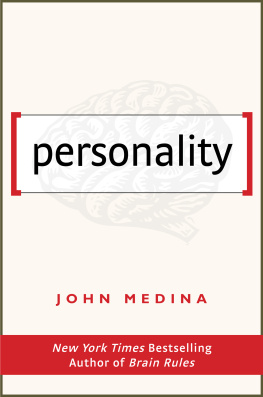1.1 Definitions of Personality
In psychology, an abundance of attempts to define the concept of personality has been proposed. Following a comprehensive contemporary definition from Ryckman () personality can be seen as
a dynamic and organized set of characteristics possessed by a person that uniquely influences his or her cognitions, motivations, and behaviours in various situations.
Ryckman sees a concept of a certain set of characteristics, i.e. characteristics may be countable in number. He does not see this set to be of random order, consequently the impact on our behavior is determined, he calls it organized . Given a directed and orderly influence we, being observer, listener or interlocutor, experience the impact of these influences by perceiving observable manifestations in respective behavioral patterns or communication. This assumption is of essential importance. Accordingly, many researchers inquiring personality have worked on diverse methods to observe, isolate and assess such observable manifestations. A further important assumption is dynamics of personality. Strength, magnitudes and sets of characteristics are expected to differ.
Pervin et al. () developed a definition that goes beyond Ryckmans theory, when he added that personality must essentially focus on consistent patterns of feelings, thoughts and behaviors . Here, personality is seen as a consistent concept, which does not contradict Ryckmans assumptions but adds another perspective that every person might have his or her unique set of consistent characteristics. Following Pervin, this also implies that personality profiles can be used to differentiate between people.
Congruent with this assumption Herrmann () describes personality as an individual-dependent unique, outlasting and stable concept. Herrman adds an expected uniqueness. In theory, if we were able to assess all aspects of a persons personality, we would be able to differentiate this person from all other persons by his or her unique personality profile. Reality teaches us, that we can neither be sure to capture all aspects of a persons personality, nor to collect enough data to verify the alleged uniqueness against all other persons.
The current focus in personality assessment is rather directed to the definition and collection of the most relevant characteristics. Researchers disagree on number and character of relevant aspects, and on how to assess these aspects. Still, when looking at different personality theories from a broader perspective, many of them seem to be at least partly complementary. Most theories do not challenge each other, they are rather seen as particularly helpful in particular situations or when looking from particular angles. For some applications or scientific questions researchers are interested in generation of a coherent personality profile of a single person, in other cases it might be helpful to investigate into how people can differ from each other considering numerous persons. Eventually, many researchers and psychologists do not explicitly identify themselves with a certain perspective but decide for the best possible explanation when examining particular issues in this respect.
This work focuses on personality as defined by Ryckmann and Pervin, and follows the hypothesis of Herrmann, assuming that people can be differentiated by their observable personality patterns. Looking from an empirical and conscious-driven perspective, a major approach is the so called trait theory of personality. According to Kassin ( provides an introduction to trait theories, their development and application.
In opposition to trait theory, another major stream of research stresses the generalizability and look for overarching characteristics in the psychology of human nature of all peoples behavior. These researchers emphasize theory development, such as the theory of psychodynamics , as developed by Freud ().
Yet other researchers see personality as determined by impacts external stimuli have on behavior, e.g. Skinner ().
1.2 Trait Theory of Personality
1.2.1 Allports Trait Organization
Gordon Allport was a pioneer in early trait research. He mainly focused on structure and membership of possible traits and created a structure of four groups, in which he arranged the trait candidates, which he also called dispositions (Allport ) he extracted 17,935 trait candidate words from the most comprehensive dictionary of English language available at that time, i.e. Websters New International Dictionary . He then reduced that huge list to a number of 4,504 adjectives, that he believed could be used to describe a persons traits. He arranged the terms due to the following semantic groups:
Neutral terms designating personal traits
Terms primarily descriptive of temporary moods or activities
Weighted terms conveying social or character judgments of personal conduct, or designating influence on others
Miscellaneous: designations of physique, capacities, and developmental conditions; metaphorical and doubtful terms
This work is widely seen as the foundation of the so called lexical approach . The basic assumption behind this approach is that important differences in characteristics to describe a personality have made their way into spoken language and the dictionary. Allport and Odbert declare:
Those individual differences that are most salient and socially relevant in peoples lives will eventually become encoded into their language; the more important such a difference, the more likely is it to become expressed as a single word.
Characteristics that cannot be expressed by isolated terms were not considered. Allport argues that observing the behavior of people is a great clue indicating to personality traits. The observation of people who like to ski, hike, and ride bikes can be used to infer that they are athletic, which he then sees as a trait. Stressing the empirical nature of his approach he declares that observing others either in natural settings or through experiments can be used to infer some of their traits.
Organizing the remaining 4,504 terms designating personal traits he set up three membership groups:
Central traits, which are general characteristics inherent to every person. While degree or magnitude can vary, these are what he called the basic building blocks that shape most of our behavior although they are not as overwhelming as cardinal traits .
Secondary traits, which show only in specific situations and are thus more peripheral
Cardinal trait, which is a trait (or a set of very few traits) that dominates and shapes a persons behavior. Regarding number of traits he declares: These are rare as most people lack a single theme that shape their lives .
Allport added another limitation to his approach by defining the common traits which are those recognized within a certain cultural background, i.e. individual trait membership and inventories may vary from culture to culture.
1.2.2 Eysencks P-E-N Theory of Super Factors
In 1947 Hans Eysenck worked on a development of his personality trait inventory. Influenced by improved techniques of statistical factor analyses at that time, he looked for correlations behind the observable traits. He referred to what he was looking for as super factors . At first, his experiments revealed two super factors, which he entitled neuroticism and extraversion (Eysenck and Lewis .










